What good are vining plants? Well, besides the obvious attribute that they do not take very much space on the ground, vining plants also can be used to screen views, cover walls or fences, and many have showy flowers which attract pollinators and hummingbirds. You can create playscapes for kids with vining plants. Or grow them over a brush pile left for the birds. Got a spot with only 12 inches of soil space at ground level, but vertical room to the sky? Vines are the answer.
As usual, before planting anything new in the garden, you need to know your site conditions and where you have space available. If you already know your garden, and you have figured out you have sandy loam soil with a pH of 6.0, in part shade, then you are set to choose plants. Knowing your site is the most important thing before picking plants.
Perennial Vining Plants
Once you know your site, you can look into the different types of vining plants to choose from. What do you want in a vine? Most nonnative vines are fast-becoming invasive, and we will look at those in this post. But first, native vines are primarily what needs to be planted. I should warn you though, almost all vines are aggressive growers, spreading at an incredible rate in comparison to trees and shrubs. Plant with caution, and only if you have a plan in place for them.
American bittersweet (Celastrus scandens) Zones 3-8
One of the most ornamental vines for fall decorations, American bittersweet is native to the Upper Midwest, Central and Northern Great Plains, and East Coast. I love this vine. Even though it is dioecious (male and female flowers are on separate plants), it is a tough, woody vine. Plant it on sturdy metal or wood trellises, or plant it by a large brush pile to cover it. The berries are an important food source for upland game birds and some songbirds.
A slower growing vine, American bittersweet grows 3 to 6 feet per year possibly more in a wetter year. It is shade tolerant, or will grow in full sun. There is an invasive species, Oriental bittersweet (Celastrus orbiculatus). Make sure you get the native species.
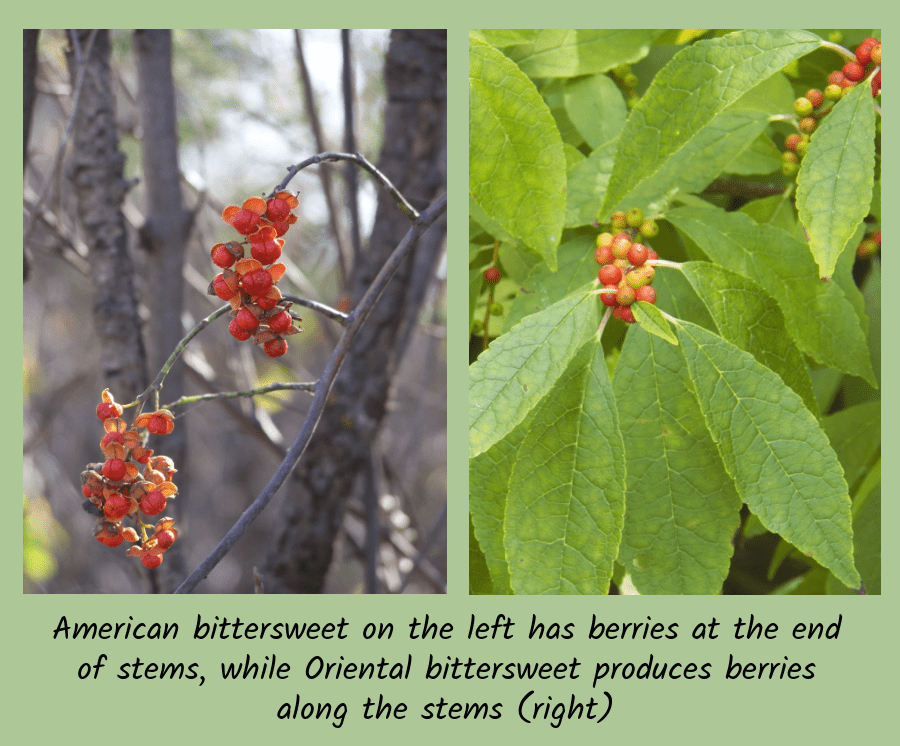
Dutchman’s Pipevine (Aristolochia tomentosa) Zones 5-8
When we first starting selling Dutchman’s pipevine in the garden center, I really was looking for pipevine swallowtails on every leaf. But, they have yet to arrive. Because it is not native specifically to Northeast Kansas, but rather to the lower portions of the Central Great Plains, local populations of pipevine swallowtail have not yet established. But according to Betsy Betros, in her book, A Photographic Field Guide to Butterflies in the Kansas City Region, it is possible.
Besides being a host plant for the pipevine swallowtail butterfly, Dutchman’s pipevine is a quick growing, somewhat spreading vine. Having planted it both for customers and at the office, I know what it can do. The fuzzy leaves are heart shaped, and the tiny, pipe-shaped flowers are interesting, though insignificant. You are growing this plant for the leaves, not the flowers. It grows 6 to 10 feet per year, depending on location. It prefers full sun to part shade.
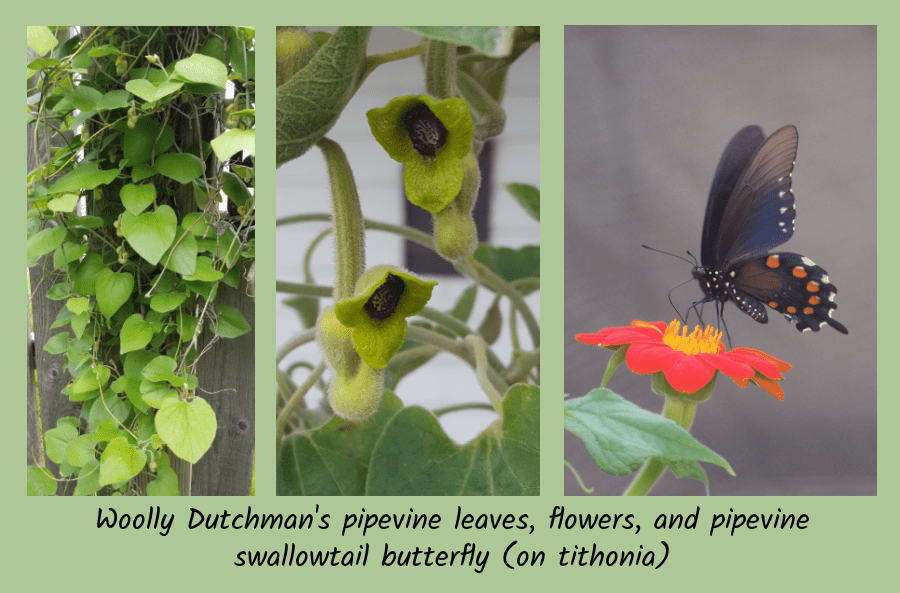
Climbing Hydrangea (Hydrangea anomala petiolaris) Zones 4-7
Native to the woodlands of Japan, this has yet to become a problem. That might be because it is not widely planted. Climbing hydrangeas use aerial roots to cling to surfaces as it grows.
What are aerial roots? These are roots that grow from branches or stems above the ground, in the air. These roots sometimes are used by plants to cling to surfaces, other times to pull water or air from the air.
The flowers of climbing hydrangea are lacecap type, similar to mountain hydrangea. They can be quite showy when in bloom. The vines are woody, and can grow to 40 feet tall, though they are slow to get there. Plant it where it gets afternoon shade, on a sturdy trellis or wall.
Coral Honeysuckle (Lonicera sempervirens) Zones 4-8
One of 4 native honeysuckle vines in the Central Great Plains, coral honeysuckle grows 3 to 20 feet tall and is great for covering trellises, arbors, and pergolas. The flowers are typically coral red tubes, which are attractive to long-tongued bees and hummingbirds. One of the reasons I love our native honeysuckles, besides the fact that they do not invade my woods recklessly, is that they are host plants for native butterflies and moths.
Coral honeysuckle grows best in full sun to part shade. It is an edge of the woods plant, meaning it often grows up trees or shrubs where the woods meet the meadow. It is a host for spring and summer azure butterflies, snowberry and hummingbird clearwing moths, plus 6 other moth species. The berries are eaten by birds.
‘John Clayton’ is a yellow flowered cultivar which grows 10 to 20 feet tall and is hardy in Zones 4 to 9.
‘Major Wheeler’ is a dark red flowered cultivar which grows 8 to 10 feet tall and wide and is hardy in Zones 4 to 8.

Virginia Creeper (Parthenocissus quinquefolia)
Most often considered an aggressive weed by gardeners, Virginia creeper grows quickly and can cover a trellis or arbor in a single year. I have seen it grow as much as 15 feet in a single season. One of its best attributes, beside quick growth, is its fall color. This vining plant turns scarlet red in autumn, a spectacular display of color.
Some 15 moths use Virginia creeper as a host plant, including 3 species of sphinx moth. Birds consume the blue berries in late summer and fall. It grows huge, up 60 feet tall if you let it. Japanese beetles do eat the leaves, but they rarely skeletonize it, because there are so many leaves on the plant.
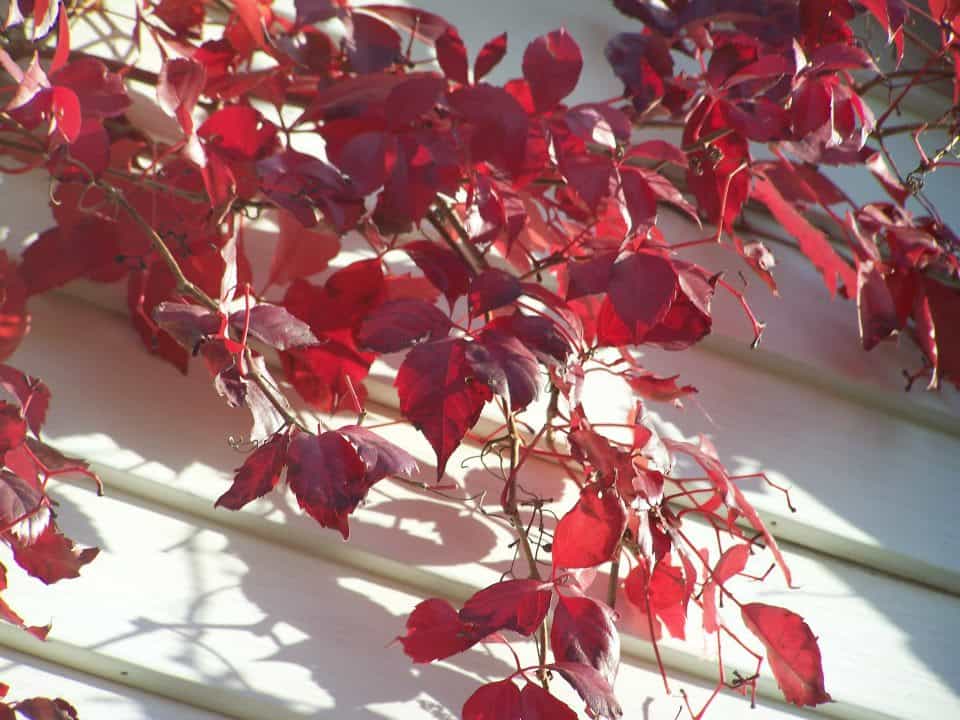
American Wisteria (Wisteria frutescens) Zones 5-9
Wisteria is one of the favorite plants of many gardeners. I usually get at least 3 customers who ask about why their wisteria is not blooming each year. The main reason wisteria does not bloom has to do with light. It prefers full sun and will rarely bloom well in shade. One of the great things about this woody vining plant is that is can be trained into a small tree form by selective pruning each year.
4 butterflies and 1 moth use wisteria as a host plant. It is also a legume, which means that in conjunction with specific mycorrhizae (fungi), the roots make nitrogen for the plant. American wisteria grows 10 to 30 feet tall over a period of time. It is great for pergolas and arbors. It could also be trained up the side of a house and over a porch or entryway for a stunning effect when in bloom. Flowers are lavender to deep purple.
‘Amethyst Falls’ is a cultivar which grows 10 to 30 feet tall and is often available at Grimm’s Gardens or other nurseries.
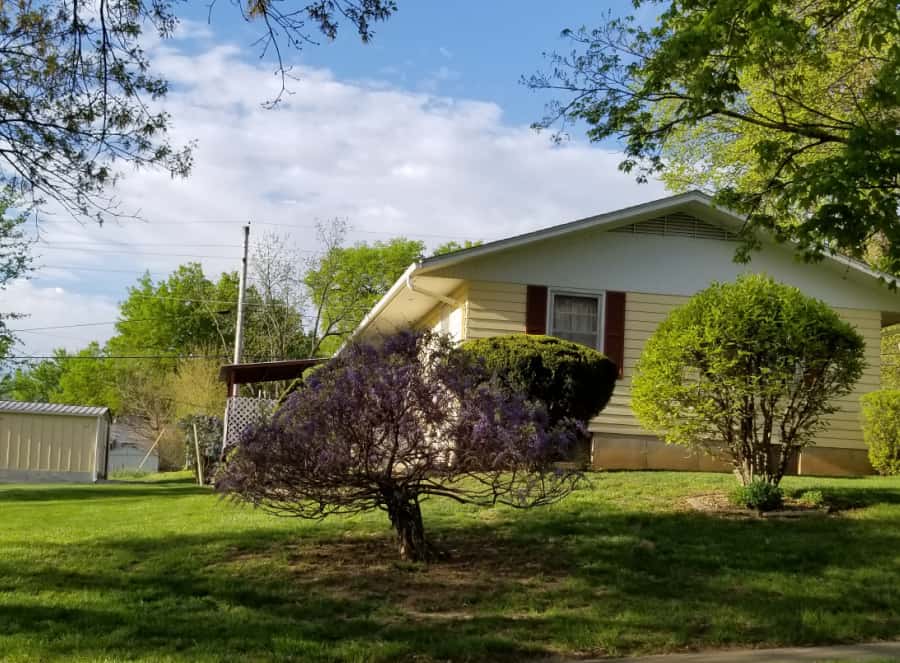
Climbing Milkweed (Cynanchum laeve)
Also known as honeyvine milkweed because its flowers are so fragrant. This perennial vine grows quickly, coving trellises, arbors, or anything else in its path. It is cousin of milkweeds (Asclepias) and is a host to the Monarch butterfly. Climbing milkweed grows 6 to 12 feet each year, dying back the ground in autumn. The fragrant flowers are visited by bees, wasps, flies, and other pollinators. It grows best in full sun.
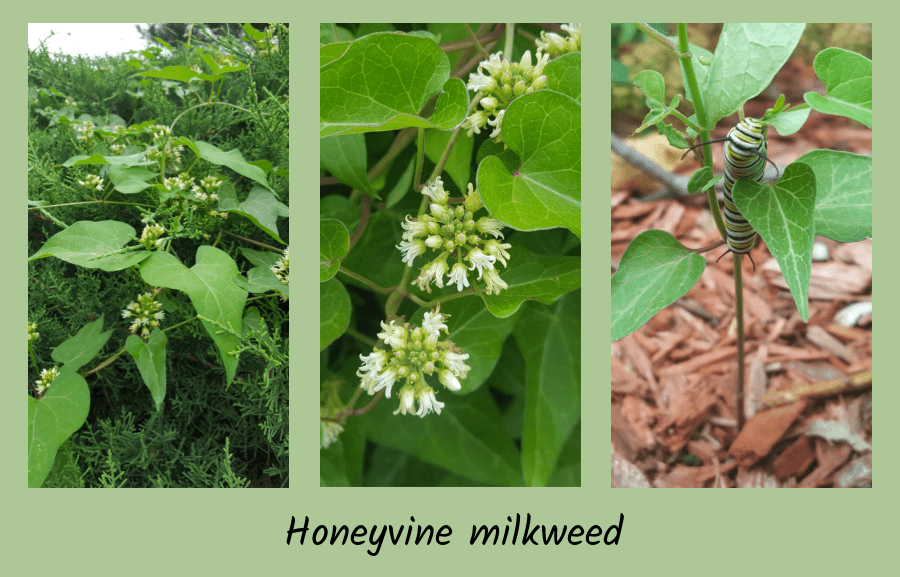
Groundnut (Apios americana)
Many of you probably have not heard of this vining plant. Groundnut is a member of the Legume Family, and is native east of the Rocky Mountains. It prefers moist soils, along streams and lakes. The tuber of the groundnut was a valuable food source for Native Americans. The flowers of this vine are quite showy, similar in shape to wisteria, but are reddish in color. It grows up to 10 feet tall and is lovely on a trellis or arbor. 2 butterflies are known to use it as a host plant.

Clematis Vines
Clematis continues to be one of the most widely used and grown vining plants in the garden. There are colors and types for nearly every situation, even part shade. Clematis has both amazing and fragrant flowers. When planting it, keep the roots cool by mulch and making sure the crown of the plant is slightly above soil level. This should prevent any problems. I find also, that it prefers to be in light shade or afternoon shade here in the Central Great Plains, as opposed to full sun.
The reason I do not include clematis up above is because it has different types. Clematis, both native and nonnative fall into 3 pruning types, which need to be recognized before planting, for best maintenance care.
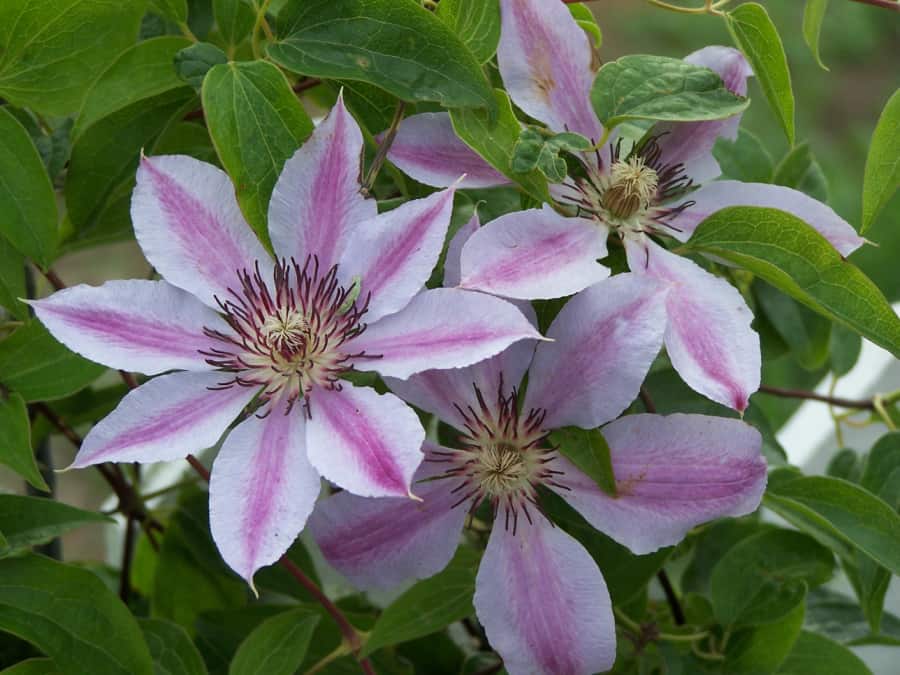
Pruning Group 1
These are varieties which produce blooms on the previous season’s growth, or old wood of several season’s worth of growth. Clematis in this group should only be pruned to remove dead or diseased vines, or to shape to a smaller size. Pruning of live vines should be done after flowering is over.

Cultivars in this group include:
- ‘Stolwijk Gold’ has chartreuse leaves with dark blue, nodding, bell-shaped flowers. Grows 6 to 8 feet tall. Hardy to Zone 4.
- ‘Freda’ has cherry-pink flowers with dark burgundy foliage. It grows 16 feet tall and is hardy to Zone 5.
Pruning Group 2
Many different varieties are found in this group. You could even call these “rebloomers” as they bloom both on the previous season’s growth and a flush of new growth of the current season. Prune these after initial flowering is done if needed. Varieties includes:
- ‘Beauty of Worcester’ has reddish-purple, double and semi-double flowers on a 6 to 8 foot tall plant. Hardy to Zone 4.
- ‘Bees Jubilee’ has mauve-pink flowers on 10 to 12 foot vines. It is hardy to Zone 4.
- ‘Guernsey Cream’ is a creamy-yellow-white flowered variety, growing 6 to 8 feet tall in Zone 4.
- ‘Henryi’ is a well-known cultivar with single, white blossom. It grows 10 to 12 feet tall. Hardy to Zone 4.
- ‘Nelly Moser’ is also a well-known cultivar, with pink petals and red stripe down the middle of each. It grows 6 to 10 feet tall. Hardy to Zone 4.
- ‘Niobe’ has reddish flowers growing on 6 to 10 foot tall plant. It is hardy to Zone 4.
Pruning Group 3
This is perhaps the easiest group to care for, because you can just cut it to the ground each year. Group 3 blooms on the current season’s growth. You do not have to cut it to the ground. Rather, you can cut it down to the lowest set of live buds in early spring or late winter. But you can cut it down too. Varieties include:
- ‘Jackmanii’ has deep purple flowers and is very well known. Growing 10 to 15 feet tall, it is hardy to Zone 4.
- ‘Rouge Cardinal’ has deep red flowers, perhaps the best red available. It grows 8 to 12 feet tall on vining plants hardy to Zone 4.
- Virgin’s Bower (C. virginiana) is a native species which flowers like the invasive sweet autumn clematis. Blooms white in late summer and early fall. It grows 15 feet tall and is hardy to Zone 4.
Invasive Vining Plants
One of the things we need to look out for when choosing plants from the nursery are invasives. Sometimes, a new plant may look so inviting and pretty that we gardeners just want to grab it and plant it. But it may be a detriment to our ecosystems in the future. We must pay attention to any plant which could become invasive or too aggressive for the garden or nature.
Chocolate Vine (Akebia quinata)
Once planted commonly for the aroma of the flowers, and the edible fruit, chocolate vine is now invasive throughout the East Coast and Midwest regions. The five-leaflet leaves are attractive, but the plant spreads and grows quickly, covering 8 to 10 feet per year. The vining plants are woody and twist around trees, shrubs, and structures easily.
Porcelain Vine (Ampelopsis brevipedunculata)
Brought to the United States from Asia, this vining plant has colorful berries in pink, blue, and purple, and sometimes variegated green and white foliage. Growing quickly, and resembling native species of Ampelopsis (Raccoon Grape) and grape, it has no natural predators here. Birds eat the berries and spread it.

Trumpet Vine (Campsis radicans)
This is a native vining plant which can be invasive or overly aggressive in a landscaped or garden setting. In the wild, nature keeps it in check. Trumpet vine is great for hummingbirds and bees, but grows very quickly and aggressively, spreading roots under concrete driveways and climbing power poles and other structures.
Japanese Honeysuckle (Lonicera japonica)
If it were not for my goats, this vine would be the bane of my property. It grows rampant in woods and fields, loving shady places better than full sun. It quickly vines and spreads up fences and shrubs, choking out native vegetation. While the flowers are fragrant, the berries produced are eaten and spread by birds.
Wintercreeper Euonymus (Euonymus fortunei)
Native to Asia, this evergreen vine uses aerial roots to attach itself to trees, shrubs, buildings, and more. Also, it spreads quickly by rhizomes, choking out plants on the forest floor. It can be difficult to eradicate, even with herbicides, because it has a waxy coating on the leaves.
Sweet Autumn Clematis (Clematis terniflora)
Unfortunately, this clematis is still be sold in garden centers across the area. A native of Asia (many of our invasives come from there), this tough vine is spread by seed and can overtake other plants in the woods or garden, choking them out. It can grow as much as 25 feet in a single season!
Conclusion
Vining plants are great additions to the garden, especially if you have limited space or vertical walls. Use vines to cover fences, arbors, pergolas, sheds, and more. They can be attractive for their leaves, flowers, and berries/fruit. Look for native or non-aggressive vines for your garden spot with limited space.
Happy planting!




